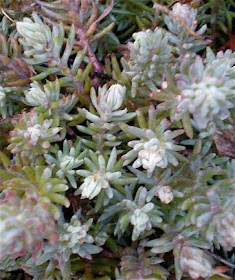Arctostaphylos uva-ursi February 2010
Veronica pectinata April 2009
Geranium orientalitibeticum May 2009
Sedum reflexum February 2010
Thymus pseudolanuginosus February 2010
Here is a list of groundcovers that grow in sun for garden in Seattle, the Pacific Northwest & USDA Zone 8. Generally, groundcovers are perennials that spread over the ground by one means or another. The exceptions here are some woody trailing or vining plants & some low spreading shrubs. Groundcovers are very helpful to control weeds. They give depth & richness to a garden. They make plantings look more natural. Choose several groundcovers if your garden is small, many if your garden is large. A single groundcover will spread throughout, looking a bit weedy. As in business, it is better to give groundcovers competition than to let them monopolize your garden. You will also get better coverage & weed-suppression by using a variety of groundcovers. Most of the groundcovers listed below tolerate dryness. Xeric plants prefer dryness & often require well-drained soil.
Groundcovers for Sun
Acaena microphylla (New Zealand Burr): xeric, spreads widely, can overwhelm smaller perennials, often used between stepping stones
Achillea millefolium (Yarrow): xeric, forms spreading mats
Achillea millefolium (Yarrow): xeric, forms spreading mats
Ajuga reptans (Carpet Bugle): many cultivars, spreads by stolons & seed, also grows in shade, shares space well
Arctostaphylos x media (A columbiana x A uva-ursi) Arctostaphylos nevadensis (Pinemat Manzanita) Arctostaphylos uva-ursi (Kinnikinnick): all xeric, spread by prostrate branches, can be controlled by pruning
Armeria maritima (Thrift): xeric, forms small mats, easy to remove
Aubrieta deltoidea (Rock Cress): forms mats, spreads by seed
Aurinia saxatilis (Basket of Gold): xeric, forms low mounds, spreads by seed
Aubrieta deltoidea (Rock Cress): forms mats, spreads by seed
Aurinia saxatilis (Basket of Gold): xeric, forms low mounds, spreads by seed
Campanula carpatica (Carpathian Harebell): forms slowly spreading mounds
Ceanothus gloriosus (Point Reyes Ceanothus) Ceanothus griseus var. horizontalis (Carmel Creeper): xeric, low spreading shrubs, can be contained by pruning
Ceanothus gloriosus (Point Reyes Ceanothus) Ceanothus griseus var. horizontalis (Carmel Creeper): xeric, low spreading shrubs, can be contained by pruning
Cerastium tomentosum (Snow in Summer): forms small mats, short-lived
Chamaemelum nobile (Roman Chamomile): tolerates some dryness, can spread invasively by seed, this is not used for tea
Erica x darleyensis (Darley Heath): low spreading shrub
Chamaemelum nobile (Roman Chamomile): tolerates some dryness, can spread invasively by seed, this is not used for tea
Erica x darleyensis (Darley Heath): low spreading shrub
Erigeron glaucus (Beach Aster): xeric, forms mats with limited spread, Erica karvinskianus (Santa Barbara Daisy): xeric, short-lived, but returns & spreads by seed
Euonymus fortunei 'Coloratus', Euonymus fortunei 'Emerald Gaiety' (Winter Creeper): low spreading shrub, tolerates dryness
Euonymus fortunei 'Coloratus', Euonymus fortunei 'Emerald Gaiety' (Winter Creeper): low spreading shrub, tolerates dryness
Euphorbia cyparissias (Cypress Spurge): xeric, spreads widely by rhizomes & seed, can be invasive, Euphorbia myrsinites (Myrtle Spurge): xeric, forms prostrate clumps, spreads by seed
Fragaria chiloensis (Sand Strawberry): tolerates dryness, spreads by runners, little fruit, Fragaria 'Pink Panda': spreads by runners, no fruit, Fragaria vesca (Woodland Strawberry): spreads widely by runners, but will share space, tasty fruits, also grows in shade
Fragaria chiloensis (Sand Strawberry): tolerates dryness, spreads by runners, little fruit, Fragaria 'Pink Panda': spreads by runners, no fruit, Fragaria vesca (Woodland Strawberry): spreads widely by runners, but will share space, tasty fruits, also grows in shade
Geranium x cantabrigiense (Dwarf Cranesbill): forms mats, tolerates dryness, Geranium orientalitibeticum (Tibetan Cranesbill): forms small patches, tolerates dryness
Hebe glaucophylla, Hebe x pimeleoides, Hebe pinguifolia 'Pagei' (Hebe): low shrubs with limited spread, tolerate dryness
Hebe glaucophylla, Hebe x pimeleoides, Hebe pinguifolia 'Pagei' (Hebe): low shrubs with limited spread, tolerate dryness
Hypericum cerastioides (St John’s Wort): forms mats, spreads from seed, easy to control
Iberis sempervirens (Evergreen Candytuft): tolerates dryness, spreads moderately to form mounds
Iberis sempervirens (Evergreen Candytuft): tolerates dryness, spreads moderately to form mounds
Juniperus conferta (Shore Juniper) Juniperus procumbens (Japanese Garden Juniper) Juniperus squamata 'Blue Carpet': tolerates dryness, shrubs form mats with prostrate branches, can be controlled by pruning
Leptinella squalida (New Zealand Brass Buttons, formerly Cotula): needs moisture, spreads widely, can overwhelm smaller perennials, often used between stepping stones
Leptinella squalida (New Zealand Brass Buttons, formerly Cotula): needs moisture, spreads widely, can overwhelm smaller perennials, often used between stepping stones
Lithodora diffusa (Lithodora): xeric, sprawls modestly
Penstemon pinifolius (Pineleaf Beardtongue): xeric, low spreading shrub
Penstemon pinifolius (Pineleaf Beardtongue): xeric, low spreading shrub
Pratia pedunculata (Blue Star Creeper, formerly Laurentia fluviatilis): tolerates dryness, spreads widely, but shares space fairly well, may prevent some bulbs from emerging
Rosmarinus officinalis ‘Prostratus’ (Trailing Rosemary): xeric, low spreading shrub
Rosmarinus officinalis ‘Prostratus’ (Trailing Rosemary): xeric, low spreading shrub
Sedum oreganum, Sedum reflexum 'Angelina', Sedum spathulifolium 'Cape Blanco', Sedum spurium (Stonecrop): xeric, spreads by rooting stems, many species & cultivars
Stachys byzantina (Lamb’s Ears): xeric, spreads widely by rooting stems & seed, but easy to remove
Thymus serpyllum (Creeping Thyme) Thymus pseudolanuginosus (Woolly Thyme): xeric, forms very low mats
Trachelospermum asiaticum (Japanese Star Jasmine): vining stems spread densely to 20 feet, use under shrubs, not with perennials
Trachelospermum asiaticum (Japanese Star Jasmine): vining stems spread densely to 20 feet, use under shrubs, not with perennials
Veronica pectinata (Woolly Speedwell): xeric, spreads very widely, but not terribly difficult to remove, Veronica prostrata (Harebell Speedwell): xeric, spreads widely, Veronica repens (Creeping Speedwell): xeric, spreads modestly





No comments:
Post a Comment